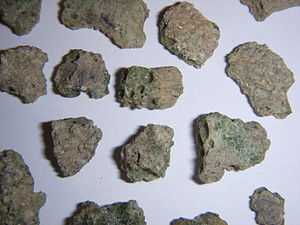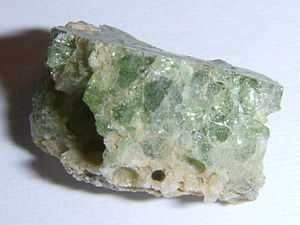Trinitite




Trinitite, also known as atomsite or Alamogordo glass, is the glassy residue left on the desert floor after the plutonium-based Trinity nuclear bomb test on July 16, 1945, near Alamogordo, New Mexico. The glass is primarily composed of arkosic sand composed of quartz grains and feldspar (both microcline and smaller amount of plagioclase with small amount of calcite, hornblende and augite in a matrix of sandy clay)[2] that was melted by the atomic blast. It is usually a light green, although color can vary. It is mildly radioactive, but is safe to handle.[3][4]
In the late 1940s and early 1950s, samples were gathered and sold to mineral collectors as a novelty. Traces of the material may be found at the Trinity Site today, although most of it was bulldozed and buried by the United States Atomic Energy Commission in 1953.[5] It is now illegal to take the remaining material from the site; however, material that was taken prior to this prohibition is still in the hands of collectors.
Formation
In 2005 it was theorized by Los Alamos National Laboratory scientist Robert Hermes and independent investigator William Strickfaden that much of the mineral was formed by sand which was drawn up inside the fireball itself and then rained down in a liquid form.[6]
A number of different types of Trinitite have been identified. Green is the most common form. Black contains iron from the tower structure. Red contains copper from the device used in the blast or from the communications cables that led away from the site. Both black and red specimens are extremely rare. Rounded "pearls" also are found, which come from melted silica that returned to solid form before hitting the ground.[7]
The glass has been described as "a layer 1 to 2 centimeters thick, with the upper surface marked by a very thin sprinkling of dust which fell upon it while it was still molten. At the bottom is a thicker film of partially fused material, which grades into the soil from which it was derived. The color of the glass is a pale bottle green, and the material is extremely vesicular with the size of the bubbles ranging to nearly the full thickness of the specimen."[2]
Occasionally, the name trinitite is broadly applied to all glassy residues of nuclear bomb testing, not just the Trinity test.[citation needed] An analog of Trinitite found in Semipalatinsk Test Site in Kazakhstan at ground zeroes of Soviet atmospheric nuclear tests is called Kharitonchik. Black vitreous fragments of fused sand that had been solidified by the heat of the explosion were described from French test site in Algeria (Reggane site).[8] There are many known fakes in circulation among collectors.[citation needed] These fakes use a variety of means to achieve the glassy green silica look as well as mild radioactivity, however, only trinitite from a nuclear explosion will contain certain neutron activation products that are not found in naturally radioactive ores and minerals. Gamma spectroscopy can narrow down the potential nuclear explosions from which the material formed.
Kharitonchik
Kharitonchiki (singular: kharitonchik [харитончик]), analogous to trinitite, are pieces of molten rock left at ground zeroes after Soviet atmospheric nuclear tests at the Semipalatinsk Test Site in Kazakhstan. This porous black material is named after one of the leading Russian nuclear weapons scientists, Yulii Borisovich Khariton.[9]
Fulgurites
While trinitite and similar materials are anthropogenic, fulgurites, found in many desert or other sandy regions, are naturally formed, hollow glass tubes composed of quartzose sand, silica, or soil generated by lightning strikes.
See also
References
- ↑ P.P. Parekh, T.M. Semkow, M.A. Torres, D.K. Haines, J.M. Cooper, P.M. Rosenberg and M.E. Kitto (2006). "Radioactivity in Trinitite six decades later". Journal of Environmental Radioactivity 85 (1): 103–120. doi:10.1016/j.jenvrad.2005.01.017. PMID 16102878.
- ↑ 2.0 2.1 Optical properties of glass from Alamogordo, New Mexico
- ↑ Kolb, W.M., and Carlock, P.G. Trinitite, 1999, The Atomic Age Mineral. This does not link to the book. http://www.orau.org/ptp/collection/hiroshimatrinity/trinitite.htm
- ↑ Nuclear weapons question, Bad Astronomy and Universe Today Forum. May not be entirely accurate. http://www.bautforum.com/general-science/9499-nuclear-weapons-question.html
- ↑ Carroll L. Tyler, AEC letter to the Governor of New Mexico, July 16, 1953.
- ↑ Robert Hermes and William Strickfaden, 2005, New Theory on the Formation of Trinitite, Nuclear Weapons Journal http://www.wsmr.army.mil/pao/TrinitySite/NewTrinititeTheory.htm
- ↑ Steven L. Kay - Nuclearon - Trinitite varieties
- ↑ Radiological Conditions at the Former French Nuclear Test Sites in Algeria: Preliminary Assessment and Recommendations International Atomic Energy Agency, 2005
- ↑ "A Nuclear Family Vacation in Russia." Slate. July 10, 2006.
External links
| Wikimedia Commons has media related to Trinitite. |
- Trinitite info and photos
- Radiographic spectrum of Trinitite
- Ralph Pray's account of removing Trinitite from the site
- Trinitite in The Corning Museum of Glass collection